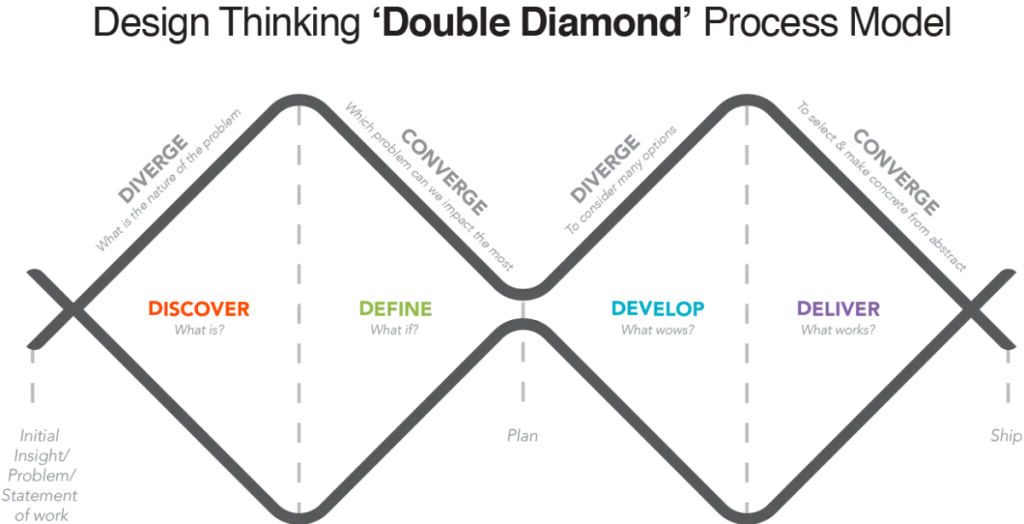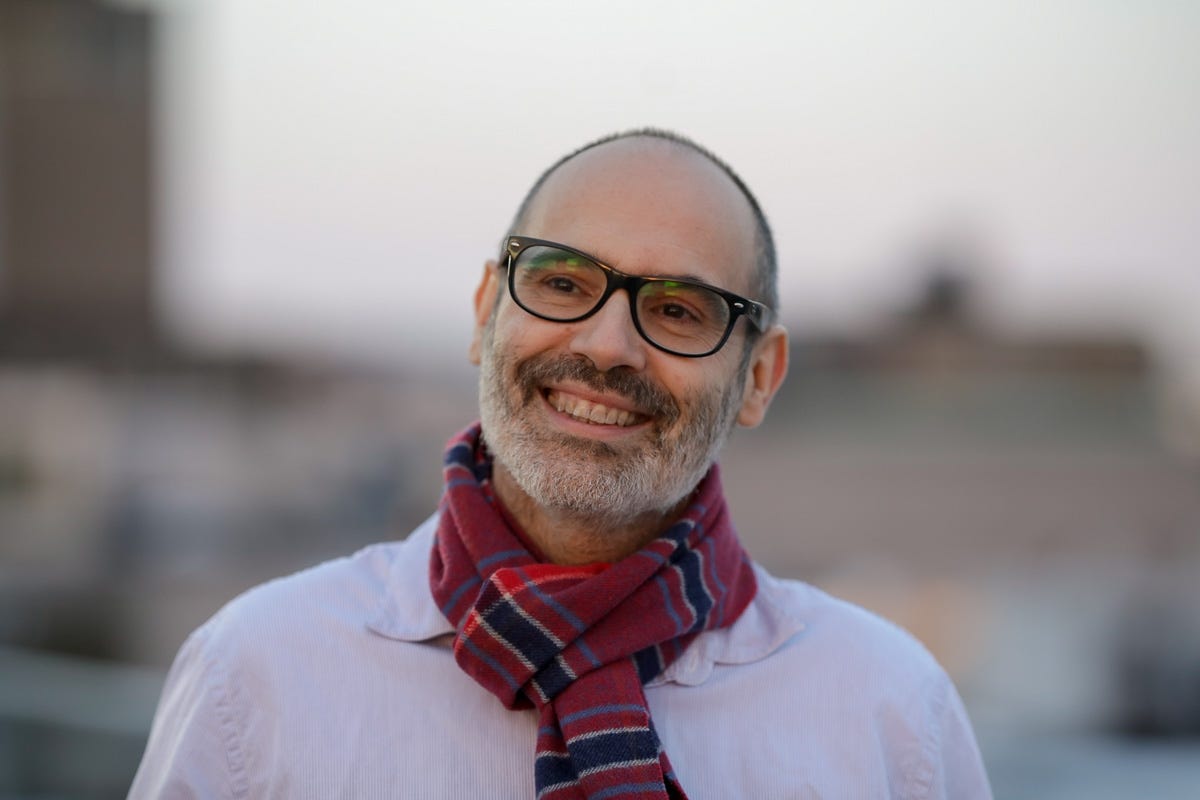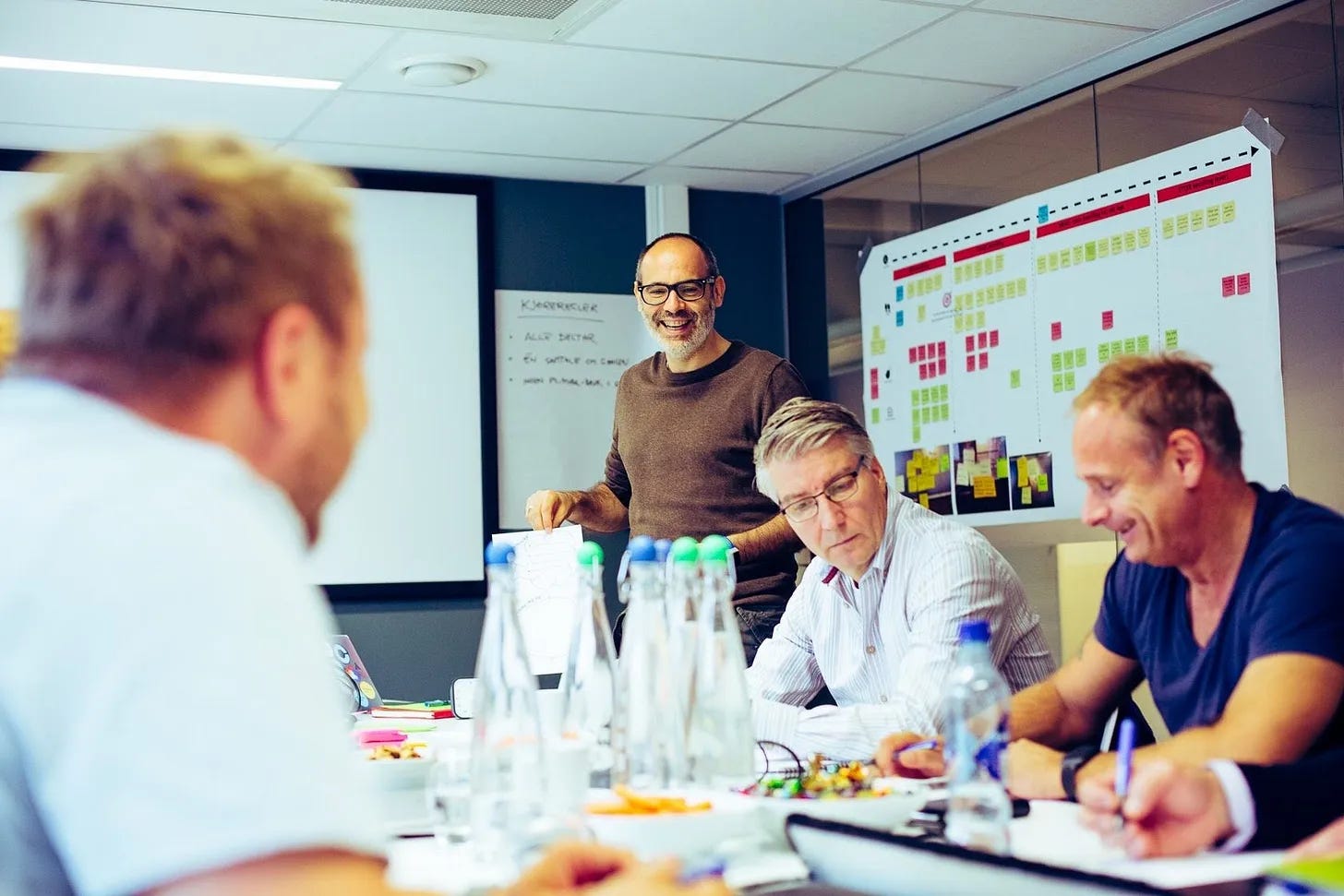Think Apart, Align Together: A Smarter Way to Use the Double Diamond with Teams
Practical Tips for Leaders
We’ve all been in those team sessions where everyone sits around a whiteboard, markers in hand, ready to brainstorm. The energy is high, but so is the noise. A few loud voices dominate, some ideas get dismissed too quickly, and before you know it, the group is circling around one or two “safe” options.
The Double Diamond model – a simple yet powerful framework in design thinking – offers us a better way. It visualizes innovation as two diamonds:
🔹 Discover → Define
🔹 Develop → Deliver
Each diamond begins with divergent thinking (opening up, exploring widely) and ends with convergent thinking (narrowing down, deciding).
But here’s the twist most teams overlook:
Divergent thinking thrives in individual work.
Convergent thinking shines in collaboration.
Divergent Thinking: Best Done Solo
When we diverge, we look for possibilities, ask questions, and gather insights. This is where imagination, curiosity, and unique perspectives come in.
The problem? Divergent thinking in a group setting can unintentionally kill diversity of thought. Group dynamics kick in:
The loudest person sets the tone.
Early ideas anchor the discussion.
Quieter team members hold back.
Solution? Give everyone space to diverge on their own first.
Encourage research, reflection, and ideation individually.
Let each team member explore their own path, jot down thoughts, and challenge assumptions before coming to the table.
The result? A richer, more diverse pool of ideas.
Convergent Thinking: Best Done Together
Once ideas are on the table, it’s time to shift gears. Convergent thinking means focusing, synthesizing, and deciding.
This is where collaboration becomes powerful. The team can:
Compare perspectives
Find patterns and overlaps
Build on each other’s insights
Make collective decisions that everyone supports
Here, group discussion brings alignment and commitment. It turns scattered brilliance into a shared vision.
Think Apart, Align Together
The magic of teamwork isn’t just about being in the same room or on the same call. It’s about thinking differently, together.
Here’s how you can apply this principle using the Double Diamond:
Diverge Individually: Ask team members to explore on their own before the meeting – whether it’s researching, mapping insights, or brainstorming ideas.
Converge Collectively: Bring the team together to analyze, prioritize, and decide. Use the power of discussion to refine, not to generate.
Practical Tips for Leaders
Give homework before the meeting.
Send prompts, data, or problem statements ahead of time.
Ask each person to write down 3–5 insights or ideas.
This ensures everyone comes in “warmed up” and ready to share.
Create space for silent idea capture.
At the start of the session, allow 5–10 minutes for people to write or sketch quietly.
This helps introverts contribute equally and prevents early anchoring around one idea.
Use structured sharing.
Go “round the table” or use digital boards (like Miro, MURAL, or FigJam) so every idea is seen before group discussion starts.
This levels the playing field.
Set clear rules for convergence.
Define criteria for decision-making (impact, feasibility, alignment with strategy).
Use voting dots, ranking, or scoring frameworks to keep the process fair and transparent.
Protect both stages.
Make sure the group doesn’t “judge too early” during divergence.
Similarly, don’t let divergence sneak back into the convergence phase—once you’re prioritizing, stick to it.
Close with ownership.
Agree on next steps, responsibilities, and timelines.
Ensure decisions made in the convergence phase turn into action.
A New Approach to Team Meetings
What if your team meetings weren’t for “throwing ideas around,” but for building on the thinking already done?
What if you treated divergence as a solo sport and convergence as a team game?
You’d unlock deeper insights, stronger decisions, and – most importantly – better collaboration.
The Takeaway
Teams often default to “group brainstorming,” but the Double Diamond teaches us something smarter: Let individuals think apart. Then align together.
Because innovation isn’t just about generating ideas.
It’s about turning diverse individual thinking into shared collective ownership and action.
I hope this post, made sense and you found it useful.
If “HELL YEAH!”, please like it and share it in social media so more people can get can also benefit from it :-)
I would also appreciate if you subscribe, and give some comments here if you wonder something and want to give me some feedback. I would love to read your input here!
If you have a Substack yourself and like my content, I would love for you to recommend “Facili-station” to your subscribers.
Have a nice one!!
Looking for a coach?
In service of those who serve others.
Leadership is hard. Whether you're stepping into management or leading an entire organization, the challenges are real: confusing, overwhelming, and sometimes isolating.
I offer tailored 1:1 or team coaching to help you move forward with clarity and confidence. I’ve walked in your shoes, and I’ll work with you to build the resilience and relational skills needed to lead well, beyond just the work.
If this sounds like what you need, let’s talk. Email me at jose@facilistation.com to book a free discovery call. Because coaching isn’t expensive. Staying stuck is.
Looking for a facilitator and workshop designer?
If you need a workshop designer and facilitator to help you or your team to solve challenges, find solutions, make decisions, and to be more effective an perform better and faster, or a trainer to teach your team on how do this, please contact me at jose@facilistation.com
My workshops are designed to provide the structure required to quickly align and move forward with a plan or idea so you can reclaim time, energy and headspace.




